Heavy machinery from an ill-fated 1900 dredger that barely started its long journey from Scotland to Japan lies off Cork in Ireland waiting for visiting divers, says JOHN LIDDIARD. Illustration by MAX ELLIS.
THIS MONTH’S TOUR IS FOR those divers who like heavy machinery. It’s the wreck of a dredger on which the hull is barely recognisable, but all the big machinery remains in a way that allows it to be mentally reassembled.
The wreck is variously known as Sento, Sante, Sente and other permutations.
I suspect that this variation comes from a Japanese name that has been translated phonetically. We use Sente here, but that does not mean it is correct!
In among all the wreckage there is a high point where debris piles up to rise some 4m above the general level of the seabed (1). Graham Ferguson dropped the shot right in the middle of this mound for my dive. From here, major trails of wreckage lead off in three directions, none of which line up.
I suspect that the Sente broke its back as it capsized and sank in a heavy sea.
Maybe the bucket-chain arm wrenched the hull apart as the ship capsized and it fell from its stowed position. Perhaps the subsequent impact with the seabed played a part.
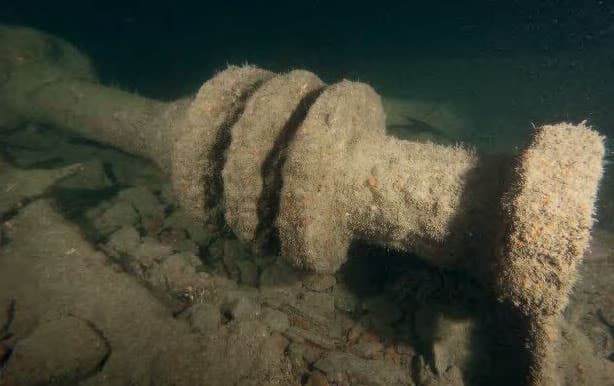
Depending on exactly where the shot lands, a quick circuit about the immediate surroundings should reveal the upturned engine base with gearbox projecting (18), the massive drive gears for the dredging
machinery (17), some solid frame sections that would have supported them (13), and a small bevelled gear and section of propeller-shaft.
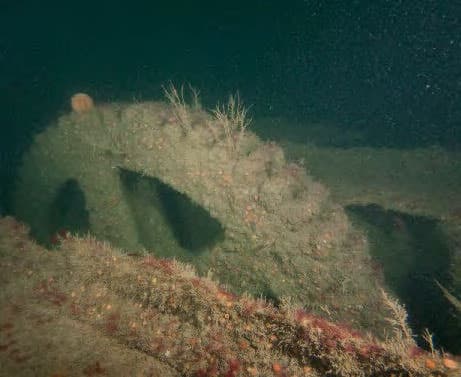
Ignoring all the big machinery for now, we begin our tour with the small bevelled gear and shaft (2). This would originally have transferred power from the main engine, with the axis oriented along the hull, through 90° to the dredging machinery, with the axis of the drive gears oriented across the hull.

From the head of this gear, the propeller-shaft (3) leads down the slope to 29m. Solid rings round the end of the shaft are part of the thrust-bearing that would have transferred thrust from the shaft to the hull.
At the bottom of this section of shaft (4) is a section of hull-plate. If you have been following down the shaft, turn 90° to the right and a few metres’ swim will bring you across a brake lever (5) for controlling
a big cable-drum winch (6).
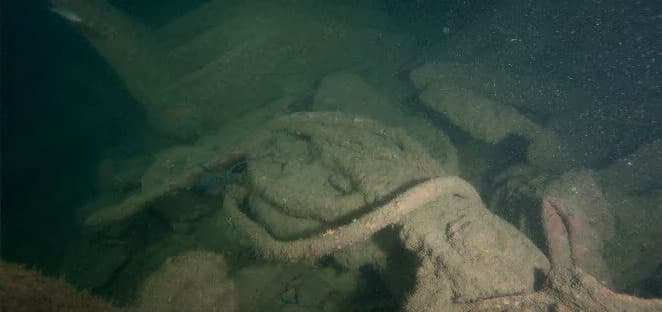
The drum is on end, and its lower end is an enormous gear. Resting against this is a second gear and section of shaft.
This is part of the mechanism to work the winch from the main engine.
The Sente was constructed with its engine towards the stern and a bucket chain that could be lowered through the forward part of the hull, so dredging towards the bow.
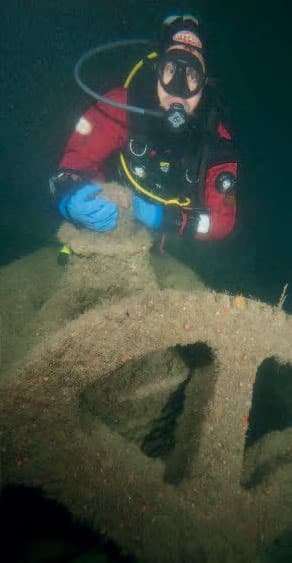
For long-term Wreck Tour followers, this is the opposite way round to how the St Dunstan was constructed (Wreck Tour 40).
This winch would have been near the head of the dredging mechanism to raise and lower it from the seabed.
Another 90° turn in our route takes us from the winch back onto the propellershaft and a section of hull (7) that leads most of the way to the stern.
The propshaft is bent off to starboard, where a smaller windlass-type anchor winch (8) rests on its mounting-plate.
Dredgers are often controlled with anchors at both ends or all four corners while working.
Following the line of the hull again, after a short break we come to the tail section of the shaft (9) leading to a four-bladed iron propeller (10) at 30m. One blade is buried in the seabed.
Part of the stern frame remains with the rudder-post (11) lying to starboard, the southernmost extremity of the wreckage.
Reversing our path, our tour now takes us back along the hull-section (12) and to the edge of the mound of debris.
Rather than rising too far up the mound, it can be skirted to the west, past the outside of the sturdy frame sections (13) mentioned earlier.
You don’t have to follow this path exactly, but I was on a rebreather and feeling stingy about wasting gas by going shallow unnecessarily.
This circuit soon intercepts the bucket-chain (14), now leading off to the north-east. A bucket-chain is exactly what its name suggests, a line of buckets linked together to form a continuous chain.
Following this outwards brings us to the head of the chain (15), wrapped round a giant sprocket that would have turned the buckets against the seabed.
The chain then loops back through 180° (16), up the slope of the debris mound to the giant main drive-gears (17). The biggest of these I estimate to be about 2.5m in diameter.
The final “arm” of our tour is the engine and boiler. The engine (18) is upside-down, crushed beneath its base. One piston lies partly buried between the engine and the main body of the mound of wreckage.
Projecting from the base are a series of gears. Unlike on a conventional steamship, the main engine of the Sente was fitted with a gearbox, so the power of the big main engine could to be used to drive both the ship via the propeller and the dredging machinery.
Beyond the engine, our tour ends at a single boiler (19).
With fairly forgiving tides, you could ascend and decompress on the shotline or on a delayed SMB.
Just make sure to discuss the plan with the skipper first, so that everyone is working from the same page of the hymn-book.
WINTER PERILS ON ROUTE FOR JAPAN
SENTE, dredger. BUILT 1900, SUNK 1900
BOTH THE Sente and St Dunstan were constructed by Lobnitz & Co of Renfrew. Owner Henry C Lobnitz was respected for the design and construction of dredgers, though the yard built all types of ship, from trawlers to tankers.
The 217-ton Sente was built for the Japanese government at a cost of £20,000. After brief trials in Greenock, on 22 December 1900 the Sente set course for Formosa, a territory of Japan at the time, with a Japanese crew, a Chinese cook and Scottish officers and engineers.
Just two days later in St George’s Channel the Sente got into difficulty in a typical south-westerly winter gale.
By Christmas Day the vessel had developed a list to port, and Captain Jameson moved 16 of the crew to the ship’s boats, nine to the larger boat and five to the smaller, towing them astern as he pointed the Sente for shelter at Cork.
Captain Jameson, the First Officer and the Chief Engineer remained on board.
Making slow progress, it was Boxing Day before the Sente was in sight of land. With the crew in the lifeboats suffering from exposure, Captain Jameson judged the worst danger to have passed, and invited them to rejoin the ship.
Those from the larger boat were soon back on board, but those in the smaller lifeboat declined, and remained on tow. By 6.30pm the Sente was in sight of the Daunt lightship and the pilot-boat Maid of Erin was approaching.
Just hours from safety, the list on the Sente began to increase.
The ship then suddenly capsized and sank by the stern in seconds. The five crew in the boat still under tow cut the rope and were rescued. There were no other survivors.
Why was this small ship designed for inshore use making a delivery voyage in mid-winter? That remains a mystery
TOUR GUIDE
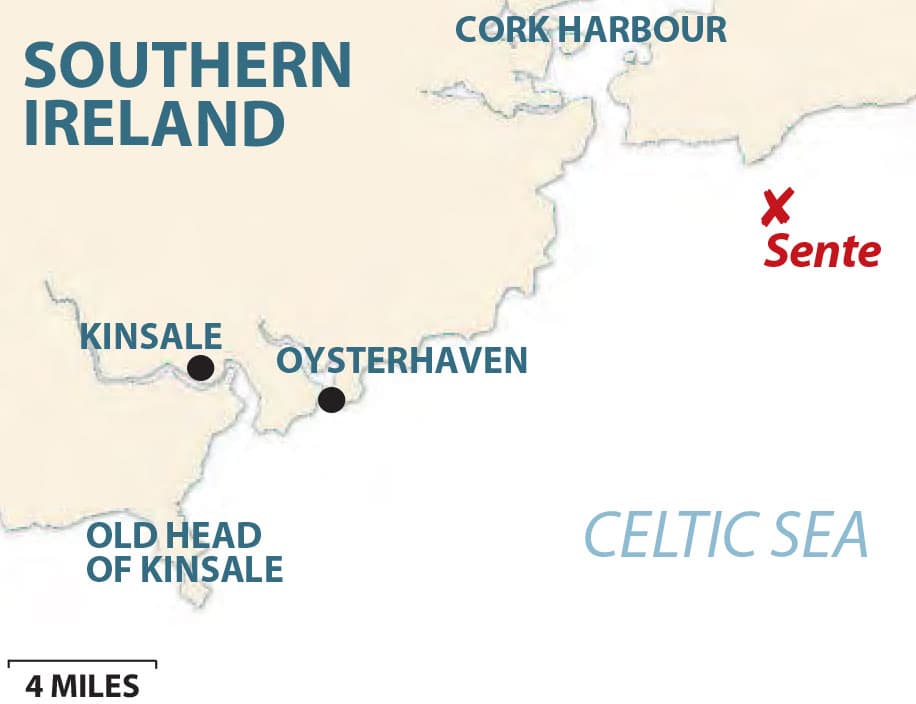
GETTING THERE: Ocean Addicts operates from Kinsale, Co Cork. Unfortunately the Swansea-Cork ferry service has ceased, so the closest ferry route from the UK is via Pembroke or Fishguard in Wales to Rosslare.
HOW TO FIND IT: The GPS co-ordinates are 51 44.674N, 008 10.440W (degrees, minutes and decimals). The stern points to the south-west, but it is hard to work out where the bow points.
TIDES: Slack water coincides with high and low water Cobh, but is only really necessary on spring tides.
DIVING & AIR: Liveaboard and RIB diving with Ocean Addicts.
ACCOMMODATION: Ocean Addicts operates the fleet tender liveaboard Embarr, with on-board accommodation for 12 divers.
LAUNCHING: Numerous slipways are available in the estuaries at Kinsale and Cork.
QUALIFICATIONS: PADI Advanced or BSAC Sports Diver.
FURTHER INFORMATION: Admiralty Chart 1765, Old Head of Kinsale to Power Head. Cork diver Tony O’Mahony runs the website Cork Ship Wrecks with information on the Sente and many other wrecks.
PROS: A perfectly sized wreck for a no-stop dive with the appropriate nitrox mix.
CONS: Harder to reach now that the Swansea-Cork ferry is out of action.
DEPTH: 20-35m
Thanks to Graham and Anne Ferguson, Adrian Dziubinski, John Collins.

